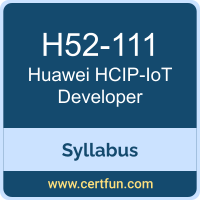 Use this quick start guide to collect all the information about Huawei HCIP-IoT Developer (H52-111) Certification exam. This study guide provides a list of objectives and resources that will help you prepare for items on the H52-111 Huawei Certified ICT Professional - IoT Developer exam. The Sample Questions will help you identify the type and difficulty level of the questions and the Practice Exams will make you familiar with the format and environment of an exam. You should refer this guide carefully before attempting your actual Huawei HCIP-IoT Developer certification exam.
Use this quick start guide to collect all the information about Huawei HCIP-IoT Developer (H52-111) Certification exam. This study guide provides a list of objectives and resources that will help you prepare for items on the H52-111 Huawei Certified ICT Professional - IoT Developer exam. The Sample Questions will help you identify the type and difficulty level of the questions and the Practice Exams will make you familiar with the format and environment of an exam. You should refer this guide carefully before attempting your actual Huawei HCIP-IoT Developer certification exam.
The Huawei HCIP-IoT Developer certification is mainly targeted to those candidates who want to build their career in Cloud Platform & Cloud Services domain. The Huawei Certified ICT Professional - IoT Developer exam verifies that the candidate possesses the fundamental knowledge and proven skills in the area of Huawei HCIP-IoT Developer.
Huawei HCIP-IoT Developer Exam Summary:
| Exam Name | Huawei Certified ICT Professional - IoT Developer |
| Exam Code | H52-111 |
| Exam Price | $300 (USD) |
| Duration | 90 mins |
| Number of Questions | 60 |
| Passing Score | 600/1000 |
| Books / Training | HCIP-IoT Developer V2.5 Training |
| Schedule Exam | Pearson VUE |
| Sample Questions | Huawei HCIP-IoT Developer Sample Questions |
| Practice Exam | Huawei H52-111 Certification Practice Exam |
Huawei H52-111 Exam Syllabus Topics:
| Topic | Details | Weights |
|---|---|---|
| HUAWEI CLOUD IoT Solution |
- IoT architecture - Huawei Internet of Things (IoT) Solution |
3% |
| Key Features of HUAWEI CLOUD IoT Solution | - Key Features of HUAWEI CLOUD IoT Solution | 8% |
| HUAWEI CLOUD IoT E2E Development |
- Overall Solution Description - What Is a Product Model? - What Is a Codec? - Northbound Service Development |
14% |
| HUAWEI CLOUD Services |
- Elastic Cloud Server (ECS) - Data Ingestion Service (DIS) - Object Storage Service (OBS) - ModelArts - HUAWEI CLOUD one-stop API Explorer |
3% |
| NB-IoT Standards and Solutions |
- NB-IoT Architecture and Protocol Evolution - Key NB-IoT Technologies |
8% |
| Huawei NB-IoT Chips and Modules |
- Introduction to NB-IoT Chips - Introduction to NB-IoT Modules |
3% |
| Technical Principles of LwM2M |
- LwM2M Features - LwM2M Objects - LwM2M Interfaces |
5% |
| Technical Principles of MQTT |
- Overview and Development History of MQTT - MQTT Publish/Subscribe Mode - MQTT Topics and QoS Levels - MQTT Packet Structure and Connection - MQTT Retained, LWT, and Keep Alive Messages |
8% |
| AT Commands for Common IoT Modules |
- Overview of E2E Integration Development - Introduction to AT Commands - NB-IoT 3GPP Commands - NB-IoT Network Access - Wi-Fi Commands |
3% |
| IoT OS |
- Introduction to RTOS - Introduction to LiteOS - Challenges Faced by IoT Software - LiteOS Architecture Design |
3% |
| Huawei LiteOS Architecture |
- Huawei LiteOS Architecture - Huawei LiteOS Kernel — Task - Kernel Modules — Task Synchronization - Kernel Modules — Memory - Kernel Modules — Interrupt - Kernel Modules — Queue - Kernel Modules — Time Management - Huawei LiteOS Middlewares - Open API - Device-Cloud Interconnection Component |
40% |
| Introduction to Common Sensors | - Introduction to Common Sensors | 2% |
To ensure success in Huawei HCIP-IoT Developer certification exam, we recommend authorized training course, practice test and hands-on experience to prepare for Huawei Certified ICT Professional - IoT Developer (H52-111) exam.
